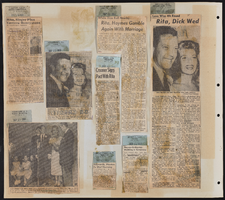Search the Special Collections and Archives Portal
Search Results
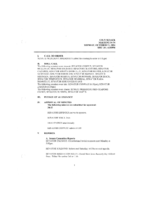
Meeting minutes for Consolidated Student Senate, University of Nevada, Las Vegas, October 11, 2004
Date
Archival Collection
Description
Text
Elizabeth Harrington Photograph Collection
Identifier
Abstract
The Elizabeth Harrington Photograph Collection (approximately 1910-1959) is comprised of black-and-white and color photographic prints and negatives. The images primarily depict the Kiwanis Club in Las Vegas, Nevada, as well as the Potosi mine in Nevada. Other images depict early Helldorado parades, airplanes at Anderson Field (Rockwell Field), and First State Bank employees. Also included are images of locations in Las Vegas, including Las Vegas grammar schools, the El Portal Theater, El Rancho Vegas, Fremont Street, Overland Hotel, and the Old Arizona Club. Additional images include portraits of Maude Frazier, Ray Lyman, and Arthur Harrington.
Archival Collection
UNLV Libraries Collection of Imperial Palace Hotel and Casino Promotional and Publicity Materials
Identifier
Abstract
UNLV Libraries Collection of Imperial Palace Hotel and Casino Promotional and Publicity Materials includes newspaper clippings, press kits, press releases, and promotional materials for the Imperial Palace in Las Vegas, Nevada, dating from 1982 to 2005.
Archival Collection
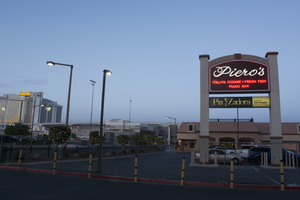
Photographs of Piero's Italian Cuisine sign, Las Vegas (Nev.), April 4, 2017
Date
Archival Collection
Description
Site address: 355 Convention Center Dr
Sign owner: Freddie Glusman
Sign details: Opened 1982, and was originally located on Karen Avenue. In 1987 the restaurant was moved to its current location on Convention Center Drive. This location claims to have an old time Vegas Rat Pack vibe. It has become a popular spot for Politicians and Mobsters
Sign condition: 5- Still in very good condition, looks nearly new
Sign form: Pylon and sign on building
Sign-specific description: On the building and the pylon sign the word "Piero's" is in white channeled neon letters in a fancy swirled font. The Pylon sign has a red background, and underneath the main logo states, " Italian Cuisine- Fresh Fish- Piano Bar" in red skeletal neon. On the building there is a red steel sign that states "Italian cuisine- Osso Bucco- Steaks- chops -Fresh Fish - Florida Stone Crab" all in white skeletal neon.
Sign - type of display: Neon
Sign - media: Steel
Sign environment: On Paradise Road and Convention Center drive next to a Las Vegas Marriott.
Sign - thematic influences: This sign showcases the use of both skeletal neon and channeled letters which gives an interesting contrast to their sign.
Sign - artistic significance: The script they use for their main logo sets the tone for the restaurant as being fancy and fine dining.
Survey - research locations: Piero's website http://pieroscuisine.com/ and photos of the property.
Surveyor: Wyatt Currie-Diamond
Survey - date completed: 2017-08-20
Sign keywords: Pylon; Neon; Steel; Building-front design; Backlit
Mixed Content
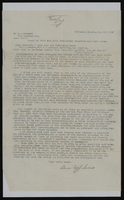
Correspondence, Levi Syphus to Sadie George
Date
Archival Collection
Description
Text
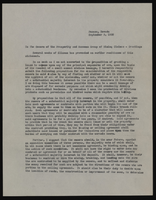
Correspondence, Levi Syphus to Sadie B. Clayton
Date
Archival Collection
Description
Text
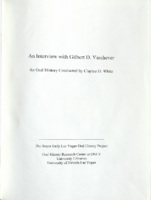
Transcript of interview with Gilbert D. Yarchever by Claytee White, 2006
Date
Archival Collection
Description
Gilbert Yarchever was one of nine siblings, born and bred in Pittsburgh, Pennsylvania. He describes the way his mother?s family was granted the last name of ?Kurfeersf" by Emperor Franz Joseph (of Austria-Hungary), explains the Seder (the Jewish observation of the exodus of Hebrews from Egypt), and tells what it was like to survive the Depression. Gilbert describes the jobs he held after high school and the government examination he took that led to his lifetime of adventure and travel. He moved to Washington, D.C., in 1940 and kept himself busy working for the government and taking classes at George Washington University, as well as working part time at Hecht Department Store and as a freelance court reporter. Following the attack on Pearl Harbor in 1941, Gilbert was sent to Africa on a merchant ship, helped smuggle Jewish survivors into Jerusalem, and was assigned the task of negotiating with Arab sheikhs for laborers to build a road. In the years after that, he worked in Europe, Panama, Alaska, Japan, and Hawaii and describes many of the jobs he was responsible for and many of the individuals he met. He also married and had children, kept up with university classes whenever he could, and collected art objects and paintings. Following his retirement in 1977, Gilbert and his family came to Las Vegas and bought a condo in Regency Towers. He did some consulting work for a couple of years, and then he and his wife began traveling around the states and going abroad. He was involved with UNLV?s EXCEL program, the music department, and the Las Vegas Art Museum. (He and his second wife Edythe presented the first major exhibition on Holocaust art at the museum.) These days Gilbert often donates pieces from his art collection to churches, synagogues, and charitable organizations.
Gilbert Yarchever was in the Navy during World War II, helped smuggle Jewish refugees into Jerusalem, worked as a civil servant in many countries, and moved to Las Vegas in 1977. He helped found the EXCEL program at University of Nevada, Las Vegas and was an art collector with his wife, Edythe Katz-Yarchever.
Text
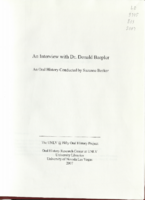
Transcript of interview with Dr. Donald Baepler by Suzanne Becker, April 23, 2007
Date
Archival Collection
Description
Text
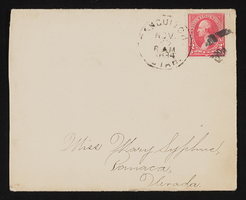
Letter and envelope from John M. Bunker, Logan, Utah to Mary Etta Syphus, Provo, Utah
Date
Archival Collection
Description
From the Syphus-Bunker Papers (MS-00169). The folder contains an original handwritten letter, an envelope, a typed transcription of the same letter, and a copy of original letter attached.
Text

